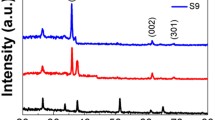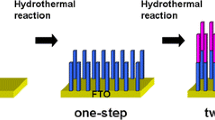Abstract
Single-crystalline TiO2 nanorod arrays (TiO2 NRAs) with dominant {001} facets sensitized with CdS nanosheets were prepared on fluorine-doped tin oxide (FTO) substrate by a simple combination of hydrothermal and successive ion layer absorption and reaction (SILAR) methods. The amount of CdS nanosheets was controlled by changing reaction time (0, 2, 6, and 10 min) in SILAR process. The effects of SILAR time on the microstructure, morphology, and optical and photoelectrochemical properties of TiO2 NRAs were investigated. Changing of SILRA times are accompanied by significant variations of optical properties including a decrease of the band gap from 2.98 to 2.41 eV and a red absorption peak shift from ultraviolet to visible region. Notably, the photoelectrochemical performance of TiO2 NRAs after 6 min SILAR deposition of CdS nonosheets improved significantly, displaying an optimal photocurrent density of 1.5 mA cm−2, which is about 15 times higher than that of pure TiO2 NRAs. This enhanced photoelectrochemical properties due to the synergistic effect of CdS nanosheets and rutile TiO2 NRAs with highly reactive {001} facets.







Similar content being viewed by others
References
Fujishima A, Honda K (1972) Electrochemical photolysis of water at a semiconductor electrode. Nature 238:37–38
Khan SUM, Al-Shahry M, Ingler WB (2002) Efficient photochemical water splitting by a chemically modified n-TiO2. Science 297(5590):2243–2245
Roy P, Berger S, Schmuki P (2011) TiO2 nanotubes: synthesis and applications. Angew Chem Int Ed 50:2904–2939
Yuan R, Chen T, Fei E, Lin J, Ding Z, Long L, Zhang Z, Fu X, Liu P, Wu L (2011) Surface chlorination of TiO2-based photocatalysts: a way to remarkably improve photocatalytic activity in both UV and visible region. ACS Catal 1:200–206
Schneider J, Matsuoka M, Takeuchi M, Zhang J, Horiuchi Y, Anpo M, Bahnemann DW (2014) Understanding TiO2 photocatalysis: mechanisms and materials. Chem Rev 114(19):9919–9986
Leschkies KS, Divakar R, Basu J, Enache-Pommer E, Boercker JE, Carter CB, Kortshagen UR, Norris DJ, Aydil ES (2007) Photosensitization of ZnO nanowires with CdSe quantum dots for photovoltaic devices. Nano Lett 7(6):1793–1798
Hamedani HA, Allam NK, El-Sayed MA, Khaleel MA, Garmestani H, Alamgir FM (2014) An experimental insight into the structural and electronic characteristics of strontium-doped titanium dioxide nanotube arrays. Adv Funct Mater 24:6783–6796
Lee K, Mazare A, Schmuki P (2014) One-dimensional titanium dioxide nanomaterials: nanotubes. Chem Rev 114(19):9385–9454
Yang XH, Li Z, Sun CH, Yang HG, Li CZ (2011) Hydrothermal stability of {001} faceted anatase TiO2. Chem Mater 23(15):3486–3491
Nian JN, Teng H (2006) Hydrothermal synthesis of single-crystalline anatase TiO2 nanorods with nanotubes as the precursor. J Phy Chem B 110(9):4193–4198
Hosono E, Fujihara S, Kakiuchi K, Imai H (2004) Growth of submicrometer-scale rectangular parallelepiped rutile TiO2 films in aqueous TiCl3 solutions under hydrothermal conditions. J Am Chem Soc 126(25):7790–7791
Cao TP, Li YJ, Wang CH, Shao CL, Liu YC (2011) A facile in situ hydrothermal method to SrTiO3/TiO2 nanofiber heterostructures with high photocatalytic activity. Langmuir 27(6):2946–2952
Tran H, Scott J, Chiang K, Amal R (2006) Clarifying the role of silver deposits on titania for the photocatalytic mineralisation of organic compounds. J Photochem Photobiol A 183(1–2):41–52
Guo Q, Xu CB, Ren ZF, Yang WS, Ma ZB, Dai DX, Fan HJ, Minton TK, Yang XM (2012) Stepwise photocatalytic dissociation of methanol and water on TiO2 (110). J Am Chem Soc 134(32):13366–13373
Li H, Chen Z, Tsang CK, Li Z, Ran X, Lee C, Nie B, Zheng L, Hung T, Lu J, Pan B, Li YY (2014) Electrochemical doping of anatase TiO2 in organic electrolytes for high-performance supercapacitors and photocatalysts. J Mater Chem A 2:229–236
Wang J, Tafen DN, Lewis JP, Hong ZL, Manivannan A, Zhi MJ, Li M, Wu NQ (2009) Origin of photocatalytic activity of nitrogen-doped TiO2 nanobelts. J Am Chem Soc 131(34):12290–12297
Song K, Wang XH, Xiang Q, Xu JQ (2016) Weakened negative effect of au/TiO2 photocatalytic activity by CdS quantum dots deposited under UV-Vis light illumination at different intensity ratios. Phys Chem Chem Phys 18:29131–29138
Tao JJ, Gong ZZ, Yao G, Cheng YL, Zhang M, Lv JG, Shi SW, He G, Jiang XS, Chen XS, Sun ZQ (2016) Enhanced optical and photocatalytic properties of Ag quantum dots-sensitized nanostructured TiO2/ZnO heterojunctions. J Alloy Compd 688(15):605–612
Liu C, Han X, Xie S, Kuang Q, Wang X, Jin M, Xie Z, Zheng L (2013) Enhancing the photocatalytic activity of anatase TiO2 by improving the specific facet-induced spontaneous separation of photogenerated electrons and holes. Chem Asian J 8(1):282–289
Ghadiri E, Liu B, Moser JE, Grätzel M, Etgar L (2015) Investigation of interfacial charge separation at PbS QDs/(001) TiO2 nanosheets heterojunction solar cell. Part Part Syst Charact 32(4):483–488
Xing MY, Yang BX, Yu H, Tian BZ, Bagwasi S, Zhang JL, Gong XQ (2013) Enhanced photocatalysis by au nanoparticle loading on TiO2 single-crystal (001) and (110) facets. J Phys Chem Lett 4(22):3910–3917
Yang J, Bao CX, Yu T, Hu YF, Luo WJ, Zhu WD, Fu G, Li ZS, Gao H, Li FM, Zou ZG (2015) Enhanced performance of photoelectrochemical water splitting with ITO@α-Fe2O3 core-shell nanowire array as photoanode. ACS Appl Mater Interfaces 7(48):26482–26490
Huang F, Hou J, Wang HJ, Tang H, Liu ZY, Zhang LS, Zhang QF, Peng SL, Liu JS, Cao GZ (2017) Impacts of surface or interface chemistry of ZnSe passivation layer on the performance of CdS/CdSe quantum dot sensitized solar cells. Nano Energy 32:433–440
Samadpour M (2017) Efficient CdS/CdSe/ZnS quantum dot sensitized solar cells prepared by ZnS treatment from methanol solvent. Sol Energy 144(1):63–70
Wang YX, Li XY, Wang N, Quan X, Chen YY (2008) Controllable synthesis of ZnO nanoflowers and their morphology-dependent photocatalytic activities. Sep Purif Technol 62(3):727–732
Wang Z, Wang XZ, Jiang XS, Tao JJ, Gong ZZ, Cheng YL, Zhang M, Yang L, Lv JG, He G, Sun ZQ (2016) CdS/ZnS co-sensitized hierarchical TiO2 nanotree array with rutile/anatase junctions for enhanced photoelectrochemical performance. J Electrochem Soc 163(10):H1041–H1046
Zheng Y, Klankowski YS, Yang Y, Li J (2014) Preparation and characterization of TiO2 barrier layers for dye-sensitized solar cells. ACS Appl Mater Interfaces 6(13):10679–10386
Zheng ZK, Xie W, Lim ZS, You L, Wang JL (2014) CdS sensitized 3D hierarchical TiO2/ZnO heterostructure for efficient solar energy conversion. Sci Rep 4:5721
Huang H, Pan L, Lim CK, Gong H, Guo J, Tse MS, Tan OK (2013) Hydrothermal growth of TiO2 nanorod arrays and in situ conversion to nanotube arrays for highly efficient quantum dot-sensitized solar cells. Small 18:3153–3160
Tian GH, Fu HG, Jing LQ, Xin BF, Pan K (2008) Preparation and characterization of stable biphase TiO2 photocatalyst with high crystallinity, large surface area, and enhanced photoactivity. J Phys Chem C 112(8):3083–3089
Zhang C, Xu YJ (2013) Ultrathin TiO2 layer coated-CdS spheres core-shell nanocomposite with enhanced visible-light photoactivity. ACS Appl Mater Interfaces 5(24):13353–13363
Wang JM, Wang ZJ, Zhu ZP (2017) Synergetic effect of Ni(OH)2 cocatalyst and CNT for high hydrogen generation on CdS quantum dot sensitized TiO2 photocatalyst. Appl Catal B-Environ 204:577–583
Meng HL, Cui C, Shen HL, Liang DY, Xue YZ, Li PG, Tang WH (2012) Synthesis and photocatalytic activity of TiO2@CdS and CdS@TiO2 double-shelled hollow spheres. J Alloy Compd 527:30–35
Wu L, Yu JC, Fu X (2006) Characterization and photocatalytic mechanism of nanosized CdS coupled TiO2 nanocrystals under visible light irradiation. J Mol Catal A-Chem 244(1–2):25–32
Gonbeau D, Guimon C, Pfister-Guillouzo G, Levasseur A, Meunier G, Dormoy R (1991) XPS study of thin films of titanium oxysulfides. Surf Sci 254(1–3):81–89
Wang W, Liu Z, Zheng C, Xu C, Liu Y, Wang G (2003) Synthesis of CdS nanoparticles by a novel and simple one-step, solid-state reaction in the presence of a nonionic surfactant. Mater Lett 57(18):2755–2760
Yousefzadeh S, Faraji M, Nien YT, Moshfegh AZ (2014) CdS nanoparticle sensitized titanium dioxide decorated graphene for enhancing visible light induced photoanode. Appl Surf Sci 320:772–779
Qin N, Liu Y, Wu W, Shen L, Chen X, Li Z, Wu L (2015) One-dimensional CdS/TiO2 nanofiber composites as efficient visible-light-driven photocatalysts for selective organic transformation: synthesis, characterization and performance. Langmuir 31(3):1203–1209
Lv P, Fu W, Mu Y, Sun H, Su S, Chen Y, Yao H, Ding D, Liu T, Wang J, Yang H (2015) Photoelectrochemical property of CdS and PbS cosensitized on the TiO2 array by novel successive ionic layer adsorption and reaction method. J Alloy Compd 621:30–34
Xie Z, Liu X, Wang W, Wang X, Liu C, Xie Q, Li Z, Zhang Z (2015) Enhanced photoelectrochemical and photocatalytic performance of TiO2 nanorod arrays/CdS quantum dots by coating TiO2 through atomic layer deposition. Nano Energy 11:400–408
Cao C, Hu C, Shen W, Wang S, Tian Y, Wang X (2012) Synthesis and characterization of TiO2/CdS core–shell nanorod arrays and their photoelectrochemical property. J Alloy Compd 523:139–145
Bai SL, Li HY, Guan YJ, Jiang ST (2011) The enhanced photocatalytic activity of CdS/TiO2 nanocomposites by controlling CdS dispersion on TiO2 nanotubes. Appl Surf Sci 257(15):6406–6409
Wu LP, Zhang YL, Li XJ, Cen CP (2014) CdS nanorod arrays with TiO2 nano-coating for improved photostability and photocatalytic activity. Phys Chem Chem Phys 16:15339–15345
Acknowledgements
This work was supported by the PHD Science Research Initiation Foundation of Anhui Jianzhu University (2016QD115) and key projects of domestic and foreign research and training of outstanding young and middle-aged backbone talents in Universities in Anhui Province (gxfxZD2016133).
Author information
Authors and Affiliations
Corresponding author
Additional information
Highlights
1. TiO2 nanorod arrays with dominant {001} facets decorated with CdS nanosheets were synthesized
2. The amount of CdS was controlled by changing reaction time in SILAR process
3. The TiO2 sensitized by CdS increase the visible-light absorption compared with the bare TiO2
4. The photoelectrochemical performance of TiO2 after 6 min SILAR deposition of CdS improved significantly, which is about 15 times higher than that of pristine TiO2
Rights and permissions
About this article
Cite this article
Wang, G., Zheng, C. & Zhou, W. Enhanced optical and photoelectrochemical performance of single-crystalline TiO2 nanorod arrays with exposed {001} facets sensitized with CdS nanosheets. Ionics 24, 1537–1544 (2018). https://doi.org/10.1007/s11581-017-2301-9
Received:
Revised:
Accepted:
Published:
Issue Date:
DOI: https://doi.org/10.1007/s11581-017-2301-9




